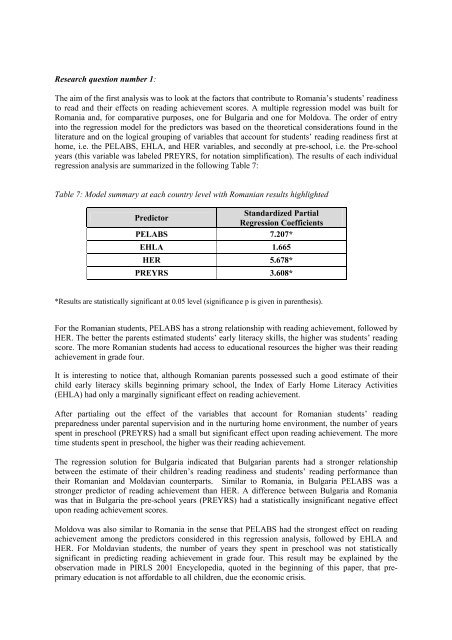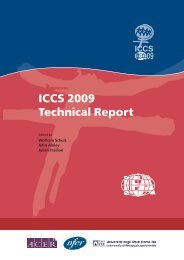THE EFFECTS OF EARLY LITERACY ACTIVITIES UPON ... - IEA
THE EFFECTS OF EARLY LITERACY ACTIVITIES UPON ... - IEA
THE EFFECTS OF EARLY LITERACY ACTIVITIES UPON ... - IEA
Create successful ePaper yourself
Turn your PDF publications into a flip-book with our unique Google optimized e-Paper software.
Research question number 1:<br />
The aim of the first analysis was to look at the factors that contribute to Romania’s students’ readiness<br />
to read and their effects on reading achievement scores. A multiple regression model was built for<br />
Romania and, for comparative purposes, one for Bulgaria and one for Moldova. The order of entry<br />
into the regression model for the predictors was based on the theoretical considerations found in the<br />
literature and on the logical grouping of variables that account for students’ reading readiness first at<br />
home, i.e. the PELABS, EHLA, and HER variables, and secondly at pre-school, i.e. the Pre-school<br />
years (this variable was labeled PREYRS, for notation simplification). The results of each individual<br />
regression analysis are summarized in the following Table 7:<br />
Table 7: Model summary at each country level with Romanian results highlighted<br />
Predictor<br />
Standardized Partial<br />
Regression Coefficients<br />
PELABS 7.207*<br />
EHLA 1.665<br />
HER 5.678*<br />
PREYRS 3.608*<br />
*Results are statistically significant at 0.05 level (significance p is given in parenthesis).<br />
For the Romanian students, PELABS has a strong relationship with reading achievement, followed by<br />
HER. The better the parents estimated students’ early literacy skills, the higher was students’ reading<br />
score. The more Romanian students had access to educational resources the higher was their reading<br />
achievement in grade four.<br />
It is interesting to notice that, although Romanian parents possessed such a good estimate of their<br />
child early literacy skills beginning primary school, the Index of Early Home Literacy Activities<br />
(EHLA) had only a marginally significant effect on reading achievement.<br />
After partialing out the effect of the variables that account for Romanian students’ reading<br />
preparedness under parental supervision and in the nurturing home environment, the number of years<br />
spent in preschool (PREYRS) had a small but significant effect upon reading achievement. The more<br />
time students spent in preschool, the higher was their reading achievement.<br />
The regression solution for Bulgaria indicated that Bulgarian parents had a stronger relationship<br />
between the estimate of their children’s reading readiness and students’ reading performance than<br />
their Romanian and Moldavian counterparts. Similar to Romania, in Bulgaria PELABS was a<br />
stronger predictor of reading achievement than HER. A difference between Bulgaria and Romania<br />
was that in Bulgaria the pre-school years (PREYRS) had a statistically insignificant negative effect<br />
upon reading achievement scores.<br />
Moldova was also similar to Romania in the sense that PELABS had the strongest effect on reading<br />
achievement among the predictors considered in this regression analysis, followed by EHLA and<br />
HER. For Moldavian students, the number of years they spent in preschool was not statistically<br />
significant in predicting reading achievement in grade four. This result may be explained by the<br />
observation made in PIRLS 2001 Encyclopedia, quoted in the beginning of this paper, that preprimary<br />
education is not affordable to all children, due the economic crisis.
















